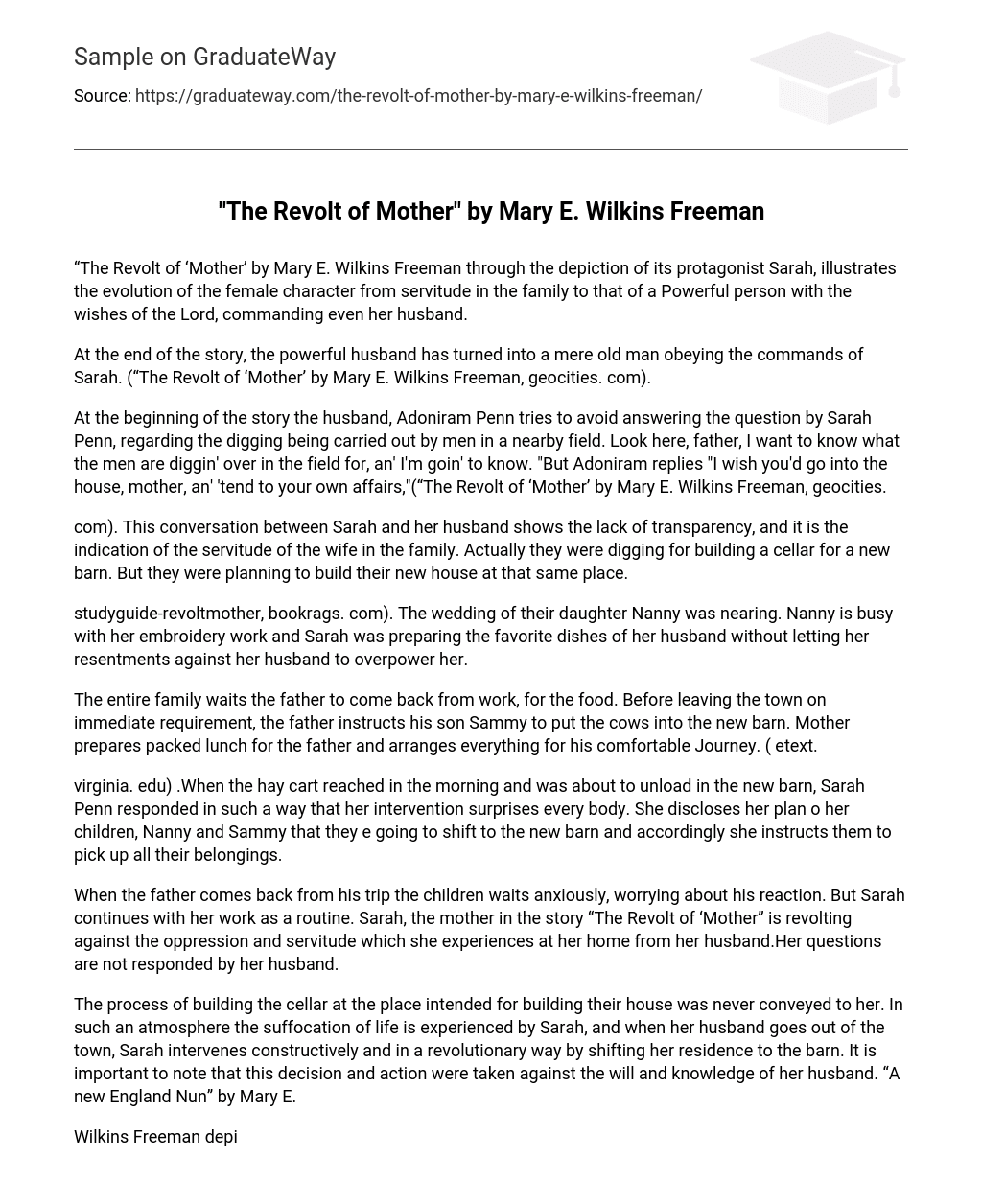In “The Revolt of ‘Mother'” by Mary E. Wilkins Freeman, the character Sarah exemplifies the transformation of women from subservience within the household to becoming powerful individuals who advocate for their own desires, even over their husbands.
According to “The Revolt of ‘Mother’ by Mary E. Wilkins Freeman” on geocities.com, the husband, who was once powerful, has transformed into an old man who now follows Sarah’s orders.
In the story, Adoniram Penn, the husband, initially tries to avoid answering his wife Sarah’s question about the digging happening in a neighboring field. Sarah insists on knowing and confronts him, saying, “I want to know what the men are diggin’ over in the field for, an’ I’m goin’ to know.” Adoniram somewhat dismissively responds, “I wish you’d go into the house, mother, an’ ‘tend to your own affairs.”
The lack of transparency and indication of the wife’s servitude in the family is evident in this conversation between Sarah and her husband. They were actually digging to build a cellar for a new barn, but their plan was to construct their new house at the same location.
According to bookrags.com’s study guide on “Revolt Mother,” Nanny and Sarah are busy preparing for Nanny’s upcoming wedding. Nanny is focused on her embroidery work while Sarah is cooking her husband’s favorite dishes, despite feeling resentful towards him.
The whole family eagerly waits for the father to return from work so they can have their meal. Before leaving the town for an urgent matter, the father tells his son Sammy to take the cows to the new barn. The mother prepares a packed lunch for the father and ensures everything is ready for his journey.
When the hay cart arrived at the new barn in the morning to unload, Sarah Penn surprised everyone with her response. She revealed to her children, Nanny and Sammy, that they were going to move to the new barn. Sarah then instructed them to gather all their belongings.
Upon the father’s return from his trip, the children anxiously wait, concerned about his reaction. However, Sarah remains steadfast in her routine, undeterred. In the story “The Revolt of ‘Mother,” Sarah rebels against the oppression and servitude she faces from her husband, seeking answers to her unanswered questions.
Sarah never learned about the construction of the cellar for their future house. This creates a stifling environment for her, and when her husband is away, Sarah takes a proactive and innovative step by moving to the barn. It is worth noting that she does this without her husband’s consent or knowledge. “A new England Nun” by Mary E.
In her story, Wilkins Freeman portrays Louisa Ellis as a strong and independent woman. Despite living alone, Louisa takes great pride in maintaining a spotless home. Occasionally, she is seen as peculiar due to her habit of wearing multiple aprons and her unique eating habits. Despite her slow and deliberate movements, Louisa prepares her tea with great care and presents it to herself as if she were a cherished guest.
According to an article on wsu.edu, Mary E. Wilkins Freeman’s “A new England Nun” portrays the solitary and inward-focused existence of Louisa.
Due to a past incident where her old dog bit a neighbor, she has always kept it chained up. This occurred fourteen years ago when the dog was just a puppy. Joe Dagget, who was her lover, received a promise from her fifteen years ago that she would marry him upon his return from Australia. Now that Dagget has come back, it is finally time for them to fulfill their promise. However, it is worth noting that Louisa has grown accustomed to her solitary life and the presence of Joe Dagget becomes disruptive to her routine.
According to Mary E. Wilkins Freeman’s story “A new England Nun” on wsu.edu, the protagonist has always anticipated her partner’s homecoming and their wedding as an expected outcome. In contrast, Joe Dagget loves Lily Dyer, who is taking care of Joe’s elderly mother.
Louisa eavesdrops on Joe and Lily’s conversation and decides to release Dagget from their promise so that he can marry Lily Dyer. Despite knowing about Dagget and Lily’s relationship, Louisa tactfully avoids mentioning Lily while conveying to Dagget that she doesn’t hold any grudge against him. She explains that she has been living a certain way for so long that she is hesitant to make a change. (“A New England Nun” by Mary E. Wilkins Freeman, wsu)
In the story “A New England Nun,” Louisa Ellis lives a solitary but content life. She is comfortable with her freedom and individuality. The only concern she has is the promise of marriage she made to Dagget. However, when he returns and she discovers Lily’s love for him, she handles the situation diplomatically and decides to part ways with Dagget.
After the unexpected separation, Louisa recovered emotionally and woke up happily the next morning to begin her cleaning job. She diligently followed her routines as she took care of her house and surroundings. Freeman, through Louisa’s story, portrays the bravery, honesty, and sacrifices of women. In doing so, she showcases her scholarly ability to present feminist arguments.
(A new England Nun and other stories, books.google)
Both “A New England Nun” and “The Revolt of ‘Mother’ by Freeman” portray female characters who are successful, independent, courageous, and practical. The protagonists, Louisa and Sarah, are both described as triumphant women.





